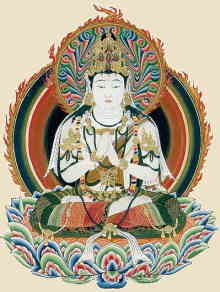SelfDefinition.Org
Tantra Articles

What is Shingon Magic? by DSZ Roshi
Shingon is the potent original Tantric Buddhism of "true words" (sometimes called Magic Words) that predates so called Vajrayana, and is infinitely more powerful. The slogan of Shingon is Sokushin jobutsu gi: "Attain enlightenment in this lifetime." [1]
[1. /tantra/kukai/1-sokushin-jobutsu-gi-introduction.htm ]
Shingon was brought to Japan by Kukai at a time when most Tibetans were still yak-herders. Admittedly, Tibetans had their own blazingly effective shamanism - Bon - that was later harried and suppressed by "Buddhists."
But although it rises from the same root as what goes by the name Vajrayana, Shingon, unlike Tibetan Tantrism, never succumbed to the fascistic excesses of Guru Yoga under the Tulku system.
All people who care about intelligent human evolution look forward to the return of Bonpo and the dismissal of feudalistic Vajrayana (with the exception of Ati Yoga, which is originally Bonpo in any case!).
Shingon Magic can help you to resist and transform the negative assaults of Vajryanists – and if you associate with any Buddhists in America right now, you are sure to experience these. But it does more. As Shugendo, it allows you to manifest the primordial Buddha Mahavairocana right here-now as the natural activity of body, speech and mind, so that you can truthfully say:
I have realized that which is unborn;
It is that which language cannot communicate;
It is free from all defilements;
It transcends causality;
I know that it is void like space.
– Mahāvairocana-sūtra, attrib. Nyorai [Tathāgata]
Shingon magic is the True Flower of enlightened Nature itself.
Svaha!
References (most links are to Wikipedia):
- Ati Yoga (Dzogchen)
- Maha Ati is a term coined by Trungpa Rinpoche to be an equivalent for Dzogpa Chenpo. Dzogchen is the natural, primordial state or natural condition of the mind.
- Bon
- The pre-Buddhist religious practices of Tibetans.
- Guru Yoga
- The practice of merging one’s mind with the "wisdom mind" of the master; visualizing the master, seeking his blessings, etc.
- Kukai
- (744-835) a.k.a. Kōbō-Daishi, "The Grand Master Who Propagated the Buddhist Teaching".
- Magic Words
- Recitation of mantras.
- Mikkyō
- Esoteric Vajrayāna practices of the Shingon, Tendai and Kegon Buddhist schools in Japan.
- Mahavairocana
- The Mahāvairocana Tantra is the earliest comprehensive manual of tantric Buddhism.
- Shingon Buddhism
- One of the few surviving Esoteric Buddhist lineages in Japan that originally spread from India to China through monks such as Vajrabodhi and Amoghavajra.
- Shugendo
- Buddhic mystical tradition originating in pre-Feudal Japan. Awakening is obtained through the understanding of the relationship between humanity and nature.
- Sokushin jobutsu gi
- "Attain enlightenment in this lifetime." See Kakui's treatise on attaining Buddhahood (link is above).
- Svaha!
- Hail! - indicating the end of a mantra. Sanskrit term used in Hinduism and Buddhism.
- Tachikawa-ryu
- A Japanese school of esoteric Buddhism founded by Nin-kan in an attempt to create a Japanese tradition corresponding to Indian Tantra.
- Tantrism
- A style of religious ritual and meditation that arose in medieval India.
- Tantras
- Numerous scriptures pertaining to esoteric Hindu or Buddhist philosophy.
- Tulku
- A particular high-ranking lama who can choose the manner of his rebirth.
- Vajrayana
- One of three vehicles or routes to enlightenment, the other two being the Hinayana and Mahayana.
- Also see:
- Kukai's Sokushin-Jobutsu-Gi, Principle Of Attaining Buddhahood With The Present Body: /tantra/
kukai/ 1-sokushin-jobutsu-gi-introduction.htm - Excerpt by Alex Wayman: Kukai and Shingon kukai-and-shingon-alex-wayman.htm